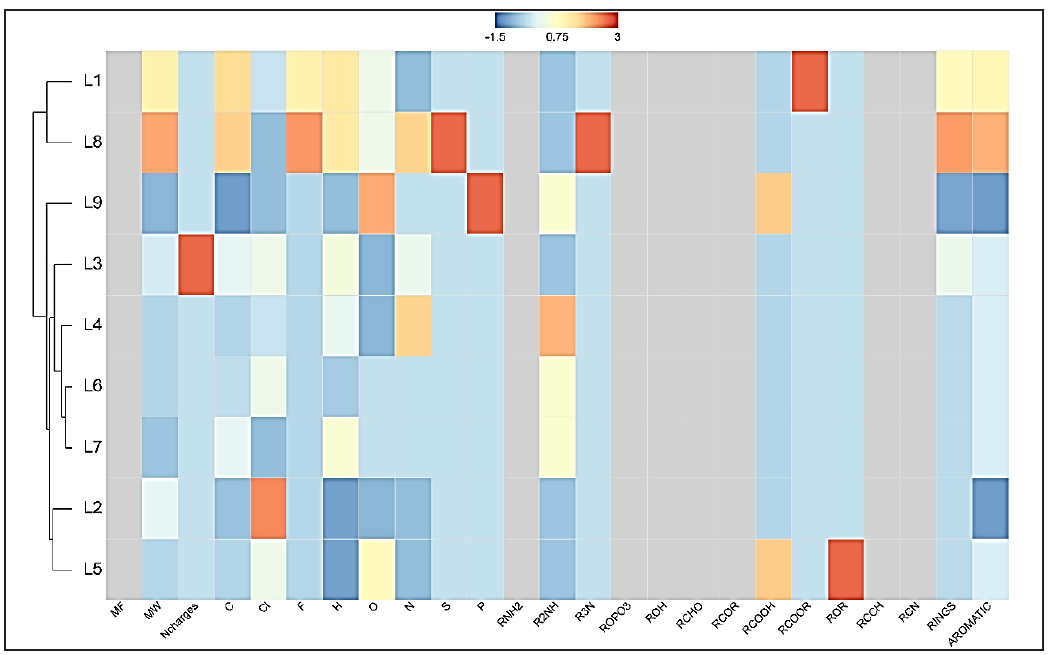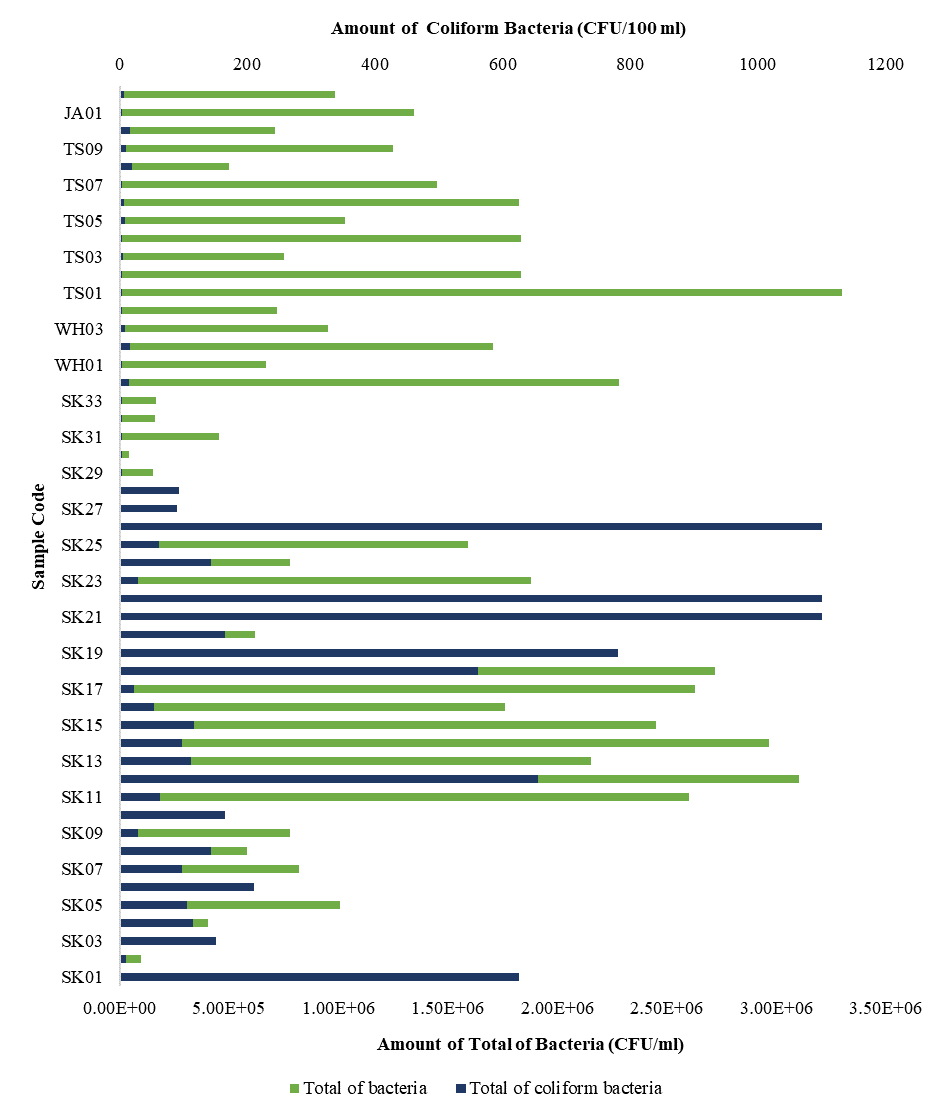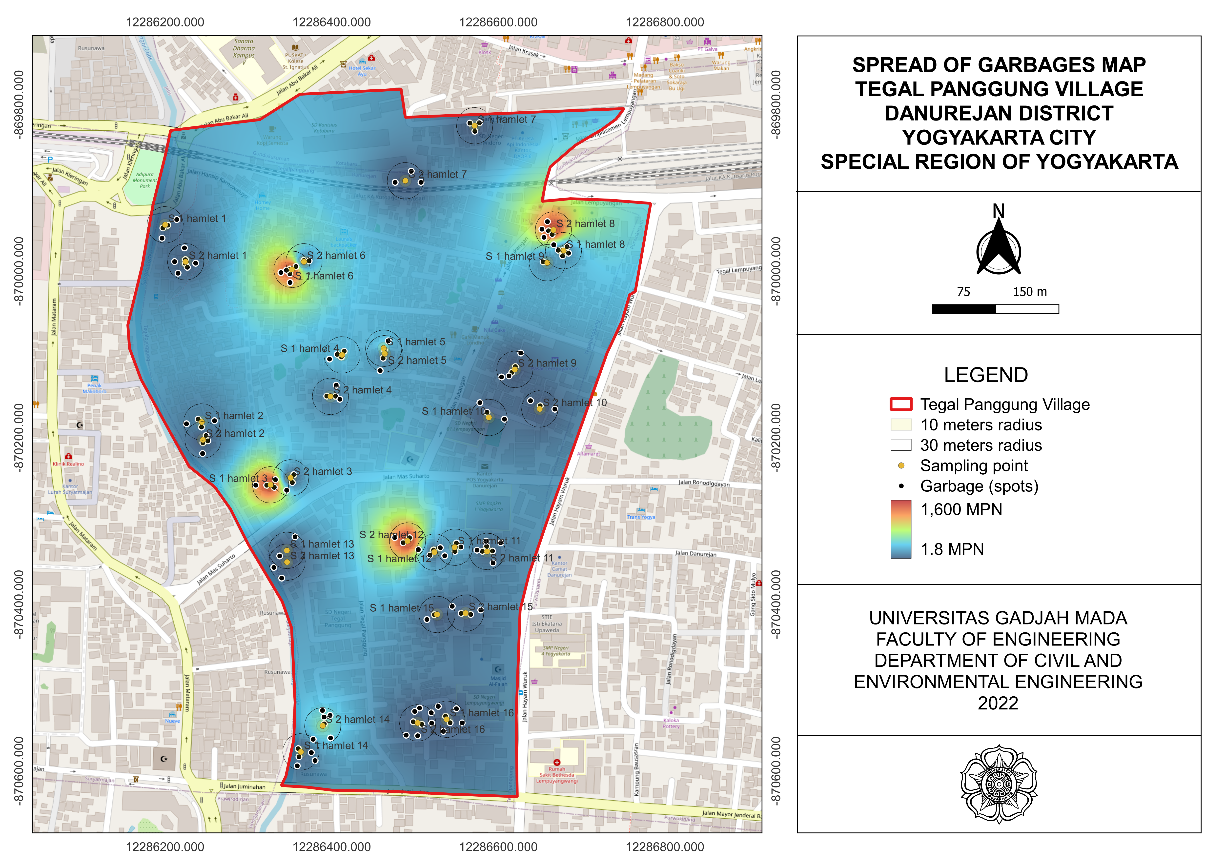In Silico Toxicological Analysis of Active Compounds Present in Selected Pesticides Sold in South-West Nigeria

Introduction: The study investigated the molecular effects of human exposure to commonly used pesticides in Nigeria. Methods: Utilizing computational methods like clustering analysis, toxicokinetic predictions, molecular docking, and molecular dynamic (MD) simulation, various health impacts were identified. Results and Discussion: The results revealed significant gastrointestinal absorption, P-glycoprotein bypass, blood-brain barrier penetration, and cytochrome P450 inhibition for certain pesticide agents. Notably, oxathiapiprolin showed hepatotoxicity, propanil exhibited drug-induced liver injury (DILI), and 2,4-dichloro-phenoxyacetic acid demonstrated carcinogenicity. Respiratory toxicity was predicted for most pesticides, except propanil and N-(2,6-diethylphenyl) acetamide. Molecular targets were identified, such as bifenthrin targeting programmed cell death 1 ligand 1 and Atrazine targeting potassium voltage-gated channel subfamily H member 3. Binding affinities were computed, with oxathiapiprolin showing -6.526 kcal/mol with short transient receptor potential channel 7. Molecular dynamic simulations indicated significant binding energy changes over time. Atrazine's binding with potassium voltage-gated channel subfamily H member 3 exhibited a total binding energy ΔGbind of -39.410 kcal/mol and -49.135 kcal/mol at 0 ns and 100 ns, respectively. Oxathiapiprolin's binding with short transient receptor potential channel 7 showed ΔGbind of -53.481 kcal/mol and -44.122 kcal/mol at 0 ns and 100 ns. Conclusion: This study suggests potential hepatotoxicity and carcinogenicity of certain pesticides, emphasizing the need for environmental monitoring and stringent regulations to safeguard public health.
Frona D, Szenderak J, Harangi-Rakos M. The Challenge of Feeding the World. Sustainability. 2019;11(20):5816. https://doi.org/10.3390/su11205816
Saravi SS, Dehpour AR. Potential Role of Organochlorine Pesticides in The Pathogenesis of Neurodevelopmental, Neurodegenerative, and Neurobehavioral Disorders: A Review. Life Sci. 2016;145(1):255–264. https://doi.org/10.1016/j.lfs.2015.11.006
Olisah C, Okoh OO, Okoh AI. Occurrence of Organochlorine Pesticide Residues in Biological and Environmental Matrices in Africa: A Two-Decade Review. Heliyon. 2020;6(3):e03518. https://doi.org/10.1016/j.heliyon.2020.e03518
Tudi M, Ruan DH, Wang L. Agriculture Development, Pesticide Application and Its Impact on the Environment. Int J Environ Res Public Health. 2021;18(3):1112. https://doi.org/10.3390/ijerph18031112
Tudi M, Ruan HD, Wang L, Lyu J, Sadler R, Connell D, et al. Agriculture Development, Pesticide Application and Its Impact on the Environment. Int J Environ Res Public Health. 2021;18(3):1112. https://doi.org/10.3390/ijerph18031112
Nicolopoulou-Stamati P, Maipas S, Kotampasi C, Stamatis P, Hens L. Chemical Pesticides and Human Health: The Urgent Need for a New Concept in Agriculture. Front. Public Health. 2016;4(148):1-8. https://doi.org/10.3389/fpubh.2016.00148
Poudel S, Poudel B, Acharya B, Poudel P. Pesticide Use and Its Impacts on Human Health and Environment. Environment & Ecosystem Science. 2020;4(1):47-51. http://doi.org/10.26480/ees.01.2020.47.51
Pathak VM, Verma VK, Rawat BS, Kaur B, Babu N, Sharma A, et.al. Current Status of Pesticide Effects on Environment, Human Health and Its Eco-Friendly Management as Bioremediation: A Comprehensive Review. Front Microbiol. 2022;13(962619):1-29. https://doi.org/10.3389/fmicb.2022.962619
Bjørling-Poulsen M, Andersen HR, Grandjean P. Potential Developmental Neurotoxicity of Pesticides Used in Europe. Environmental Health. 2008;7(50):1-22. https://doi.org/10.1186/1476-069X-7-50
Özkara A, Akyıl D, Konuk M. Pesticides, Environmental Pollution, and Health. In Environmental Health Risk-Hazardous Factors to Living Species; London: IntechOpen; 2016. https://doi.org/10.5772/63094
Melanda VS, Galiciolli MEA, Lima LS, Figueiredo BC, Oliveira CS. Impact of Pesticides on Cancer and Congenital Malformation: A Systematic Review. Toxics. 2022;10(11):676. https://doi.org/10.3390/toxics10110676
Wickerham EL, Lozoff B, Shao J, Kaciroti N, Xia Y, Meeker JD. Reduced Birth Weight in Relation to Pesticide Mixtures Detected in Cord Blood of Full-Term Infants. Environment International. 2012;47(1):80–85. https://doi.org/10.1016/j.envint.2012.06.007
Mostafalou S, Abdollahi M. Pesticides and Human Chronic Diseases; Evidences, Mechanisms, and Perspectives. Toxicology and Applied Pharmacology. 2013;268(2):157-177. https://doi.org/10.1016/j.taap.2013.01.025.
Verger PJ, Boobis AR. Reevaluate Pesticides for Food Security and Safety. Science. 2013; 341(6147):717–718. https://doi.org/10.1126/science.1241572
Mascarelli A. Growing Up with Pesticides. Science. 2013;341(1):740–741. https://doi.org/10.1126/science.341.6147.740
Gea M, Zhang C, Tota R, Gilardi G, Nardo GD, Schiliro T. Assessment of Five Pesticides as Endocrine-Disrupting Chemicals: Effects on Estrogen Receptors and Aromatase. Int J Environ Res Public Health. 2022;19(4):1959. https://doi.org/10.3390/ijerph19041959
Pognan F, Beilmann M, Boonen H. The Evolving Role of Investigative Toxicology in the Pharmaceutical Industry. Nat Rev Drug Discov. 2023;22(1):317–335. https://doi.org/10.1038/s41573-022-00633-x
Kaufmann D, Ramirez-Andreotta MD. Communicating the Environmental Health Risk Assessment Process: Formative Evaluation and Increasing Comprehension Through Visual Design. J Risk Res. 2020;23(9):1177-1194. https://doi.org/10.1080/13669877.2019.1628098
Udoh GD, Gibbs JL. Commentary: Highlighting the Need for Pesticides Safety Training in Nigeria: A Survey of Farm Households in Rivers State. Frontier Public Health. 2022; 10(988855):1-4. https://doi.org/10.3389/fpubh.2022.988855
Ibraheem O, Fatoki TH, Enibukun JM, Faleye BC, Momodu DU. In Silico Toxicological Analyses of Selected Dumpsite Contaminants on Human Health. Nova Biotechnologica et Chimica. 2019;8(2):144-153. https://doi.org/10.2478/nbec-2019-0017
Fatoki TH, Chukwuejim S, Ibraheem O. Harmine and 7,8-dihydroxyflavone Synergistically Suitable for Amyotrophic Lateral Sclerosis Management: An Insilico Study. Res Results Pharmacol. 2022;8(3):49-61. https://doi.org/10.3897/rrpharmacology.8.83332
Daina A, Michielin O, Zoete V. SwissADME: A Free Web Tool to Evaluate Pharmacokinetics, Drug-Likeness and Medicinal Chemistry Friendliness of Small Molecules. Scientific Report. 2017;7(1): 42717. https://doi.org/10.1038/srep4271
Keiser MJ, Roth BL, Armbruster BN, Ernsberger P, Irwin JJ, Shoichet BK, et al. Relating Protein Pharmacology by Ligand Chemistry. Nature Biotech. 2007;25(2):197-206. https://doi.org/10.1038/nbt1284
Morris GM, Huey R, Lindstrom W, et.al. AutoDock4 and AutoDockTools4: Automated Docking with Selective Receptor Flexibility. J Comput Chem. 2009;30(16):2785–2791. https://doi.org/10.1002/jcc.21256
Trott O, Olson A J. AutoDock Vina: Improving the Speed and Accuracy of Docking with a New Scoring Function, Efficient Optimization, and Multithreading. J Comput Chem. 2010;31(2):455–461. https://doi.org/10.1002/jcc.21334
Eberhardt J, Santos-Martins D, Tillack AF, Forli S. AutoDock Vina 1.2.0: New Docking Methods, Expanded Force Field, and Python Bindings, J Chem Inf Model. 2021;61(8):3891-3898. https://doi.org/10.1021/acs.jcim.1c00203
Fatoki TH. Human Adenovirus DNA Polymerase is Evolutionarily and Functionally Associated with Human Telomerase Reverse Transcriptase Based on in Silico Molecular Characterization that Implicate Abacavir and Zidovudine. Front Bioinform. 2023;3(1123307):1-20. https://doi.org/10.3389/fbinf.2023.1123307
Tao A, Huang Y, Shinohara Y, Caylor ML, Pashikanti S, Xu D. ezCADD: A Rapid 2D/3D Visualization-Enabled Web Modeling Environment for Democratizing Computer-Aided Drug Design. J Chem Inf Model. 2019;59(1):18−24. https://doi.org/10.1021/acs.jcim.8b00633
Ajayi II, Fatoki TH, Alonge AS, Famusiwa CD, Saliu IO, Akinlolu OS, et al. In Silico ADME and Molecular Simulation Studies of Pharmacological Activities of Phytoconstituents of Annona muricata (L.) Fruit. Journal of Food Bioactives, 2024;25(1):81-94. https://doi.org/10.31665/JFB.2024.18374
Schrödinger. Desmond Molecular Dynamics System, D.E. Maestro Desmond Interoperability Tools. New York: Schrödinger; 2018.
Fatoki TH, Awofisayo OA, Ibraheem O, Oyedele AS, Akinlolu OS. In silico Investigation of First-Pass Effect on Selected Small Molecule Excipients and Structural Dynamics of P-glycoprotein. Bioinformatics and Biology Insight. 2020;14(32782427):1-9. https://doi.org/10.1177/1177932220943183
Fatoki TH, Faleye BC, Nwagwe OR, Awofisayo OA, Adeseko CJ, Jeje TO, et al. Friedelin Could Moderately Modulate Human Carbonic Anhydrases: An in Silico Study. Biointerface Research in Applied Chemistry, 2024;14(2):49. https://doi.org/10.33263/BRIAC142.049
Schrödinger. What do all the Prime MM-GBSA Energy Properties Mean?. New York: Schrödinger; 2019. www.schrodinger.com/kb/1875
Li Y, Meng Q, Yang M, Liu D, Hou X, Tang L, et al. Current Trends in Drug Metabolism and Pharmacokinetics. Acta Pharm Sin B. 2019;9(6):1113-1144. https://doi.org/10.1016/j.apsb.2019.10.001
Fang W, Peng Y, Muir D, Lin J, Zhang X. A Critical Review of Synthetic Chemicals in Surface Waters of the US, the EU and China. J Environ Int. 2019;131(104994):1-9. https://doi.org/10.1016/j.envint.2019.104994
Shan W, Hu W, Wen Y, Ding X, Ma X, Yan W, et al. Evaluation of Atrazine Neurodevelopment Toxicity in Vitro-Application of Hesc-Based Neural Differentiation Model. Reproductive Toxicology. 2021;103(1):149–158. https://doi.org/10.1016/j.reprotox.2021.06.009
Uwazie CC, Pirlot BM, Faircloth TU, Patel M, Parr RN, Zastre HM, et al. Effects of Atrazine Exposure on Human Bone Marrow-Derived Mesenchymal Stromal Cells Assessed by Combinatorial Assay Matrix. Front Immunol. 2023;14(1214098):1-18. https://doi:10.3389/fimmu.2023.1214098
Harper AP, Finger BJ, Green MP. Chronic Atrazine Exposure Beginning Prenatally Impacts Liver Function and Sperm Concentration with Multi-Generational Consequences in Mice. Front Endocrinol. 2020;11(580124):1-13. https://doi.org/10.3389/fendo.2020.580124
Genovese T, Siracusa R, Fusco R, D’Amico R, Impellizzeri D, Peritore AF, et al. Atrazine Inhalation Causes Neuroinflammation, Apoptosis and Accelerating Brain Aging. Int J Molecular Sciences. 2021;22(15):7938. https://doi.org/10.3390/ijms22157938
Huang P, Yang J, Song Q. Atrazine Affects Phosphoprotein and Protein Expression in MCF-10A Human Breast Epithelial Cells. Int J Mol Sci. 2014;15(1):17806-17826. https://doi:10.3390/ijms151017806
Purcell M, Neault JF, Malonga H, Arakawa H, Carpentier R, Tajmir-Riahi HA. Interactions of Atrazine and 2,4-D with Human Serum Albumin Studied by Gel and Capillary Electrophoresis, and FTIR spectroscopy. Biochimica et Biophysica Acta. 2001;1548(1):129-138. https://doi.org/10.1016/S0167-4838(01)00229-1
Costas-Ferreira C, Durán R, Faro LRF. Toxic Effects of Glyphosate on the Nervous System: A Systematic Review. Int J Molecular Sciences. 2022;23(9):4605. https://doi.org/10.3390/ijms23094605
Chen Y, Zhang F, Huang B, Wang J, Huang H, Song Z, et.al. Effects of Oxathiapiprolin on the Structure, Diversity and Function of Soil Fungal Community. Toxics. 2022;10(9):548. https://doi.org/10.3390/toxics10090548
Kornepati AVR, Vadlamudi RK, Curiel TJ. Programmed Death Ligand 1 Signals in Cancer Cells. Nat Rev Cancer. 2022;22(3):174-189. https://doi.org/10.1038/s41568-021-00431-4
Ghit A, Assal D, Al-Shami AS, Husssein DEE. GABAA Receptors: Structure, Function, Pharmacology, and Related Disorders. J Genet Eng Biotechnol. 2021;19(1):123. https://doi.org/10.1186/s43141-021-00224-0
Fu X, Wang YJ, Kang JQ, Mu T. GABAA Receptor Variants in Epilepsy. Brisbane (AU): Exon Publications; 2022. https://doi.org/10.36255/exon-publications-epilepsy-gaba-receptor
Borowicz-Reutt K, Czernia J, Krawczyk M. Genetic Background of Epilepsy and Antiepileptic Treatments. Int J Mol Sci. 2023;24(16280):1-8. https://doi.org/10.3390/ijms242216280
Sieghart W, Chiou LC, Ernst M, Fabjan J, Savic MM, Lee MT, et al. α6-Containing GABAA Receptors: Functional Roles and Therapeutic Potentials. Pharmacol Rev. 2022;74(1):238-270. https://doi.org/10.1124/pharmrev.121.000293
Sigel E, Steinmann ME. Structure, Function, and Modulation of GABAA Receptors. J Biological Chemistry. 2012;287(48):40224-4023. https://doi.org/10.1074/jbc.R112.386664
Bachmann M, Li W, Edwards MJ, Ahmad Sa, Patel S, Szabo I, et al. Voltage-Gated Potassium Channels as Regulators of Cell Death. Front Cell Dev Biol. 2020;8(611853):1-13. https://doi.org/10.3389/fcell.2020.611853
Hansen RT, Conti M, Zhang HT. Mice Deficient in Phosphodiesterase-4A Display Anxiogenic-Like Behavior. Psychopharmacology. 2014;231(15):2941–2954. https://doi:10.1007/s00213-014-3480-y
Kupczyk M, Kuna P. Targeting the PGD2/CRTH2/DP1 Signaling Pathway in Asthma and Allergic Disease: Current Status and Future Perspectives. Drugs. 2017;77(1):1281–1294. https://doi.10.1007/s40265-017-0777-2
Souza-Tavares H, Miranda CS, Vasques-Monteiro IML, Sandoval C, Santana-Oliveira DA, Silva-Veiga FM, et al. Peroxisome Proliferator-Activated Receptors as Targets to Treat Metabolic Diseases: Focus on the Adipose Tissue, Liver, and Pancreas. World J Gastroenterol. 2023;29(26):4136-4155. https://doi.org/10.3748/wjg.v29.i26.4136
Mangelsdorf D J, Thummel C, Beato M, Herrlich P, Schutz G, Umesono K, et al. The Nuclear Receptor Superfamily: The Second Decade. Cell. 1995;83(6):835–839. https://doi:10.1016/0092-8674(95)90199-X
Mithaiwala MN, Santana-Coelho D, Porter GA, O’Connor JC. Neuroinflammation and the Kynurenine Pathway in CNS Disease: Molecular Mechanisms and Therapeutic Implications. Cells. 2021;10(6):1548. https://doi:10.3390/cells10061548
Karagiota A, Chachami G, Paraskeva E. Lipid Metabolism in Cancer: The Role of Acylglycerolphosphate Acyltransferases (AGPATs). Cancers. 2022;14(1):228. https://doi.org/10.3390/cancers14010228
Lu B, Jiang YJ, Zhou Y. Cloning and Characterization of Murine 1-Acyl-Sn-Glycerol 3-Phosphate Acyltransferases and Their Regulation by PPARalpha in murine heart. Biochem. J. 2005;385(1):469–477. https://doi.org/10.1042/BJ20041348
Cardinali DP. Melatonin: Clinical Perspectives in Neurodegeneration. Front Endocrinol. 2019; 10(480):1-22. https://doi.org/10.3389/fendo.2019.00480
Starnes AN, Jones JR. Inputs and Outputs of the Mammalian Circadian Clock. Biology. 2023; 12(4):508. https://doi.org/10.3390/biology12040508
Nanduri R, Furusawa T, Bustin M. Biological Functions of HMGN Chromosomal Proteins. Int J Mol Sci. 2020;21(2):449. https://doi:10.3390/ijms21020449
Vangeel L, Voets T. Transient Receptor Potential Channels and Calcium Signaling. Cold Spring Harb Perspect Biol. 2019;11(6):a035048. https://doi.org/10.1101/cshperspect.a035048
Liu Y, Lyu Y, Wang H. TRP Channels as Molecular Targets to Relieve Endocrine-Related Diseases. Front Mol Biosci. 2022;9(895814):1-22. https://doi.org/10.3389/fmolb.2022.895814.
Jeong JH, Lee SH, Kho AR, Hong DK, Kang DH, Kang BS. The Transient Receptor Potential Melastatin 7 (TRPM7) Inhibitors Suppress Seizure-Induced Neuron Death by Inhibiting Zinc Neurotoxicity. Int J Molecular Sciences. 2020;21(21):7897. https://doi.org/10.3390/ijms21217897
Fatoki TH, Ajiboye BO, Aremu AO. In Silico Evaluation of the Antioxidant, Anti-Inflammatory, and Dermatocosmetic Activities of Phytoconstituents in Licorice (Glycyrrhiza glabra L.). Cosmetics. 2023;10(3):69. https://doi.org/10.3390/cosmetics10030069

This work is licensed under a Creative Commons Attribution-NonCommercial-ShareAlike 4.0 International License.
1. Copyright of all journal manuscripts is held by the Jurnal Kesehatan Lingkungan.2. Formal legal provisions to access digital articles of electronic journal are subject to the provision of the Creative Commons Attribution-ShareAlike license (CC BY-NC-SA), which means that Jurnal Kesehatan Lingkungan is rightful to keep, transfer media/format, manage in the form of databases, maintain, and publish articles.
3. Published manuscripts both printed and electronic are open access for educational, research, and library purposes. Additionally, the editorial board is not responsible for any violations of copyright law.
JKESLING by UNAIR is licensed under a Creative Commons Attribution-ShareAlike 4.0 International License.







































